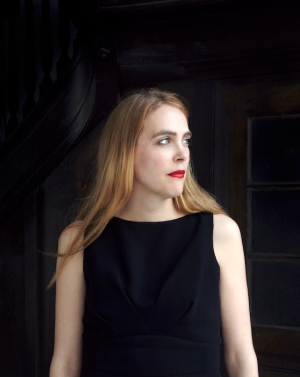Swiss Pavilion at the 56th International Art Exhibition – la Biennale di Venezia
Pamela Rosenkranz
Curator: Susanne Pfeffer
Palazzo Trevisan, Venice
For her exhibition the artist has teamed up with the German curator Susanne Pfeffer, director of the Fridericianum in Kassel since 2013. In addition to her role as chief curator of KW Institute for Contemporary Art in Berlin and a curator for MoMA PS1 in New York, Susanne Pfeffer has curated many critically acclaimed exhibitions internationally, such as «Absalon», «Kenneth Anger» and «nature after nature». Pamela Rosenkranz and Susanne Pfeffer have previously worked together closely on the exhibition «Speculations on Anonymous Materials» at the Fridericianum Kassel in 2013.
Susanne Pfeffer comments: «I am interested in how Pamela reflects on technological change and the associated transformation in contemporary philosophy, science, global economy and consumer behaviour in her work. Rosenkranz confronts us with materials and concepts which, through their ubiquity, have become determinants of our time while remaining difficult to perceive.»
Pamela Rosenkranz’s work takes aim at the empty centers of history, politics, and contemporary culture as a whole. It addresses the shifting philosophical and scientific meanings of the ‘natural’ and the ‘human’ during Anthropocene (the geological epoch marked by the impact of human activities on the ecosystem). Rosenkranz deploys a palette of patented icons—polyethylene water bottles, soft drinks, Ralph Lauren latex paint, JPEGs of International Klein Blue, Ilford photo paper, and ASICS sneakers—augmented by flesh-toned silicone and acrylic paint. Her insistence on the ‘naturalness’ of these seemingly unnatural materials is premised on the fact that they were all produced by human activity.
The domestication and commodification of organically occurring entities under contemporary capitalism is evoked through corporate slogans: Fiji’s “Untouched by man;” Evian’s “The most important body of water is yours;” ASICS’s anima sana in corpore sano. Rosenkranz views bottles of water as small bodies of nature, marketed as a health and beauty product that cleanses the human body from the inside out. Eternal youth and the preservation of purity are branded and sold as beauty ideals. She short-circuits this conceit by filling the branded vessels with flesh-toned silicone, a material ordinarily used to smooth the appearance of skin on camera, as though a homogenized solution of one’s own body.
The color blue, engaged through scientific and art historical discourses, is a recurrent motif. The ability to perceive blue was developed at a pre-evolutionary stage when life forms solely existed underwater, and humans remain more sensitive to it than any other color. Further, blue irises were a physical feature first developed to attract sexual partners for reproduction. “Our vision, like our other sense organs, is not abstract, but is very much influenced and shaped by the long natural history of the species that preceded humankind,” Rosenkranz notes.
The series Because they try to bore holes appropriates unauthorized reproductions of Yves Klein’s International Klein Blue (which he claimed had the capacity to cause viewers to transcend material concerns and induce a sensation of boundlessness) for opposite ends: the bubbles which populate Rosenkranz’s hand-mounted inkjet prints foreground immanence and material constraint. In contrast to Klein, she undermines the claim that art might transcend its immediate reality; here, the signification of apparent gesturality is reduced to its evolutionary and capitalist conditions of production. Rosenkranz’s universe is one in which the artist must be reduced to the physical interactions of neurochemical processes. Subjectivity itself becomes mere material.
Pamela Rosenkranz was born in Uri, Switzerland in 1979. She received her MFA from the Academy of Fine Arts, Bern, in 2010, and completed an independent residency at the Rijksakademie in Amsterdam in 2012. She was recently nominated for the Böttcherstraße Prize, Kunsthalle Bremen, and in exhibitions at the Migros Museum für Gegenwartskunst (Zürich), the Kunsthalle Wien, the Astrup Fearnley Museet (Oslo), and the ICA London. Forthcoming exhibitions include Between Discovery and Invention: 20 Years of Collecting, Zabludowicz Collection, London, UK.
Susanne Pfeffer is an art historian and curator. Since June 2013, she has been the director of the Fridericianum in Kassel, where she curated the exhibitions Speculations on Anonymous Materials, nature after nature and Paul Sharits. A Retrospective, among others. Previously, Pfeffer was the chief curator of KW Institute for Contemporary Art in Berlin (2007-2012) and acted as curator and advisor for MoMA PS1 in New York. From 2004 until 2006, she was artistic director of Künstlerhaus Bremen. Additionally, Pfeffer has curated exhibitions at the São Paulo Biennial, the Lyon Biennial, the Tel Aviv Art Museum, Museum Boijmans Van Beuningen, the Museum of Modern Art in Warsaw and the Museion Bolzano. She has realized notable solo exhibitions and retrospectives of artists such as Absalon, Joe Coleman, Cyprien Gaillard, Emily Jacir, Sergej Jensen, Renata Lucas, Helen Marten and Wael Shawky.
«S.O.S. DADA – The World Is A Mess»
The programme of this year’s forth edition of the «Salon Suisse» at the Palazzo Trevisan degli Ulivi is structured by the two Dada-specialists Juri Steiner and Stefan Zweifel. For the «Salon» entitled «S.O.S. DADA – The World Is A Mess» Steiner and Zweifel invite their guests from all over the world to discuss the cross-epochal force and the timelessness of Dada. Events and discussions about the art movement Dada, its past, presence and future are to take place on five weekends over the course of the Biennale, which takes place from 9 May to 22 November 2015.
The «Salon», initiated by Pro Helvetia in 2012, makes use of the spotlight at the Biennale di Venezia to further connect the Swiss art scene internationally. In a relaxed atmosphere it offers a platform for lively exchange, bringing together artists, experts, students and other interested visitors from across the world.
Image: Susanne Pfeffer, © Angela Bergling.


